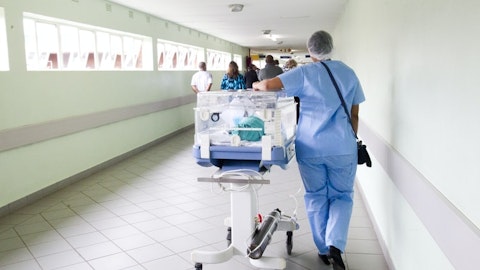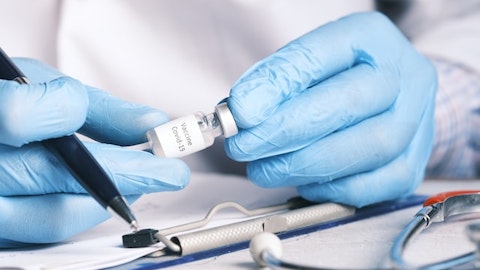Jason Clemens: Sure. So maybe start with a level setting of 2023 by quarter. In Q1 2023, CapEx represented 12% of revenue. And as reported, that was related to a purposeful stockpiling of CPAPs that we felt was necessary to meet the continued demand in sleep therapies. And then that dialed off to kind of high-10%, mid-10% and then low-10%, 10.3% for Q4. And so that kind of mid-10% range is a good run rate. We think we’ll get half a point out in 2024, which is why free cash flow conversion is up half a point. Structurally, what’s changing here is technology really related to the Oracle fixed assets and inventory digitalization project that we’ve been hard at work on for about a year now. That is taking hold. We just went live within the last few weeks in our first sites for HME, and we’re finding benefit there of compressing our day’s hand on inventory and just getting more efficient about the way we order, how we order, and just kind of what we’re comfortable with in terms of min to maxes [ph].
And we expect to bring more improvement throughout the year.
Eric Coldwell: Thanks very much. Nice seeing the good progress here. Congrats.
Richard Barasch: Thanks, Eric.
Operator: Thank you. We’ll take our next question from Matthew Blackman with Stifel. Your line is open.
Unidentified Analyst: Good morning, guys. This is Colin on for Matt. I thought I’d start by asking for a bit of a state of a union of sorts on the diabetes franchise, particularly on the CGM side. Are you seeing any lift from basal patients, particularly the Medicare, coverage decision that went through last year, or any new centers like the G7 launch? And is the government mix going to stabilize this year? What are your thoughts around that? I know that’s still a priority.
Richard Barasch: Hey. It’s a compound question. Let me start. And then this is Richard. I’ll turn it over to Jason. We’re not seeing the benefits yet from the extensions in Medicare and in some of the other governmental programs. But we think we will in 2024. So that’s a pillar of why we think we can ultimately get back to more growth so that we see as upside for going forward. Jason, why don’t you repeat? You asked a compound question. Jason’s got it.
Jason Clemens: Yes. I’d say, Colin, as it relates to newer products and those trends we are distributing the newer models for both DexCom and Abbott. They’ve been great partners and we’re continuing to run that transition frankly faster than we had planned for expected. And we think that’s a good thing obviously for our patients and then certainly for our economics. I guess I’d say in terms of the government split, we think that we will grow that government census a touch more in 2024. And the reason is the doubling of the sales force is really intended to go after geographies that we’ve never been in before. And so as you’d expect a lot of data and analysis went into where the business is, what we think these geographies, particularly urban areas will produce.
And we’re pointed directly at a primary care sale, which happens to be a very heavily government patient population. And so again we do expect to grow in that area in 2024, and particularly in the second half of the year we expect to get back to growth mode.
Unidentified Analyst: And then I had one follow-up on the gross margin outperformance during the quarter. Was that primarily a function of the Humana dynamic or any one-time items, or was it just the underlying business and the COGS efficiencies that you’ve put in place this year? How should we think about that kind of progressing into 2024? Thanks.
Richard Barasch: I’d say all the above, Colin. I mean, we were just pleased. Frankly we beat on essentially every assumption, every measure. Humana, to your point we have done a good job transitioning patients, and we have gone faster than we committed to, which is resulting in a big improvement in Q4 over Q3. Secondly, in reference to the cost management program when you look across labor, OpEx and G&A, I mean, Q4 is essentially flat over the prior year. And so the company was able to deliver on that that cost containment program and then also deliver what I think is about $80 million of growth over the prior year. So, I mean, it’s really those couple of factors that drove the performance in the quarter.
Unidentified Analyst: Thank you so much.
Operator: Thank you. We’ll take our next question from Pito Chickering with Deutsche Bank. Your line is open.
Pito Chickering: Hey, good morning. Thanks for taking my questions. Going back to sleep rentals for a second, I understand the flat growth guidance for 2024 just due to really tough comps in 2023. If I just plug 2024 into a CAGR from 2022, it’s about 12%. Is that the right growth we should be thinking about for 2025 for sleep rentals?
Jason Clemens: Well, I’d say Pito the sleep as a category mid- to upper-single digit as Richard alluded to across the enterprise, we think that sleep growth will continue to be healthy. Once you get to a point that your comparable period is clean, then yes, I mean, both whether it’s rental or resupply, it should grow at approximately the same rate.
Pito Chickering: Okay, great. And then a few follow ups here on diabetes. What percent of your pumps today are tubeless versus tubed? What’s the cost difference for patients if they get a tubeless pump and a pharmacy versus a DME? And then where do you think that the pair mix ends the year?
Jason Clemens: For 2024?
Pito Chickering: Yes.




